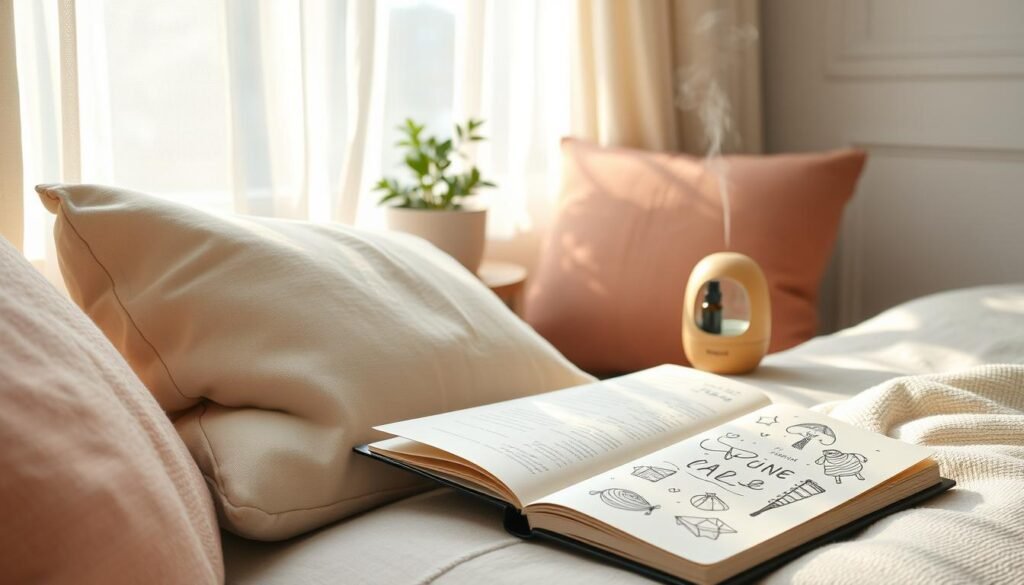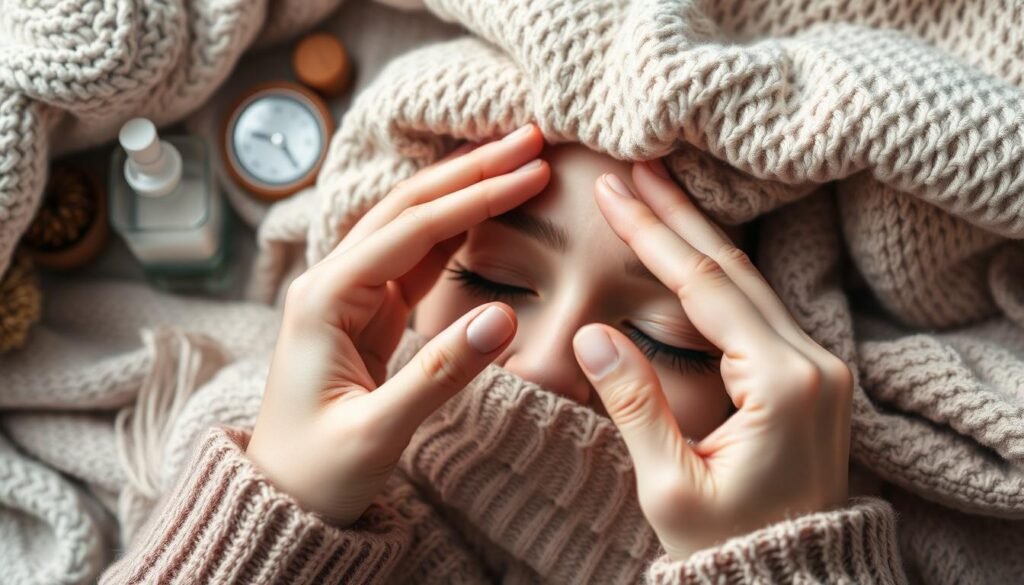More than 3.7 million people in the US have trichotillomania. This condition is closely tied to habits like rubbing eyebrows when nervous. Rubbing your eyebrows often starts as a way to handle stress and worry. It can feel like a short escape from tension.
This action might seem small but can grow into a big issue affecting your daily life and how you interact with others. We’ll look into how rubbing your eyebrows when anxious is linked to mental health. And we will understand why a simple habit can become a big problem.
Key Takeaways
- Rubbing eyebrows anxiety is often a compulsive action linked to emotional regulation.
- This habit can provide temporary stress relief but may develop into a long-term problem.
- Trichotillomania frequently starts in early adolescence, highlighting the importance of early intervention.
- Genetic factors may influence the likelihood of developing rubbing eyebrows anxiety.
- The condition affects millions, with more women seeking treatment than men.
- Effective coping strategies, such as habit reversal training, can help manage symptoms.
- Awareness and support play crucial roles in addressing this common nervous habit.
Understanding Rubbing Eyebrows Anxiety
Rubbing your eyebrows when stressed is common. It’s a way to calm yourself during tough times. When people do this, they’re trying to control their anxiety symptoms. This action helps them feel balanced even when their mind feels out of order.
The Psychological Perspective
Rubbing your eyebrows is a habit some turn to when stressed or bored. It’s a sign that someone wants to soothe difficult emotions. Many people do things over and over when worried. Recognizing this can help understand how it eases anxiety for a while.
Those who often rub their eyebrows might be dealing with issues like those seen in trichotillomania. That means they might pull their hair due to overwhelming urges. This act is a way to deal with emotions and can offer short-term relief. The link between feeling anxious and repetitive behaviors is key to managing anxiety.
What Is Trichotillomania?
Trichotillomania, often called hair-pulling disorder, is a mental health condition. It leads to a strong urge to pull out one’s hair from different body parts, such as the scalp, eyebrows, and eyelashes. This habit can start in childhood or adolescence and may continue into adulthood. People with this disorder pull hair due to stress, anxiety, or emotional distress.
This disorder is one type of body-focused repetitive behavior (BFRB). It’s related to habits like nail-biting and skin picking. Some individuals with trichotillomania also develop trichophagia, meaning they chew or swallow the pulled hair. This behavior can cause bald spots, skin damage, infections, and issues from eating hair. These problems show why it’s important to understand and treat this condition.
Trichotillomania can come from genetics, hormonal changes, or learned behaviors. Effective treatments include behavior therapies like habit-reversal training. This therapy teaches people to recognize triggers and find other ways to deal with them. Taking part in stress-reducing actions such as exercise, meditation, or hobbies can help too. Beating trichotillomania takes patience, support, and effort.
| Aspect | Description |
|---|---|
| Condition | Trichotillomania (hair-pulling disorder) |
| Prevalence | Affects approximately 0.5% to 3.4% of adults at some point in life, with a higher frequency in women (9:1 ratio) |
| Common Behaviors | Pulling hair from scalp, eyebrows, eyelashes; may chew or swallow hair |
| Potential Consequences | Bald patches, skin infections, social anxiety, emotional distress |
| Treatment Approaches | Cognitive Behavioral Therapy (CBT), habit-reversal training, stress management techniques |
The Link Between Anxiety and Rubbing Eyebrows
Rubbing your eyebrows can be a sign of stress. It is a common behavior for those feeling anxious or emotionally troubled. People do this to feel better instantly, as it helps soothe themselves. This action can make you feel calmer for a short time by releasing dopamine.
About 1 in 20 people engage in body-focused repetitive behaviors (BFRBs). Many don’t know they have habits like eyebrow rubbing. It happens more in women than in men. These actions usually occur during stressful times, showing how anxiety and rubbing your eyebrows are connected.
Many people show different behaviors when anxious, including nail-biting and hair-pulling. Research suggests up to 30% of individuals do these without even knowing. This shows that we often try to manage anxiety subconsciously. Understanding these behaviors can help find better ways to deal with stress.
Symptoms of Rubbing Eyebrows Anxiety
Rubbing eyebrows anxiety shows through various symptoms. It impacts a person’s emotional health. Individuals may feel a strong need to rub their eyebrows. This often leads to unease or tension before the act.
The relief or satisfaction felt afterwards starts a difficult cycle. Breaking this cycle isn’t easy.
This behavior isn’t just a simple habit. It can be part of a broader anxiety problem. Common issues include:
- Tension or apprehension before the urge arises
- A sense of relief or calm after rubbing
- Irritability and restlessness
- Difficulty concentrating due to anxiety symptoms
- Skin irritation or discomfort around the eyebrows
It’s important to know how these symptoms relate to emotional control. Emotional reactions can make the need to rub eyebrows stronger. Learning how to manage these feelings is key to cutting down on anxiety.
| Symptoms | Description |
|---|---|
| Persistent urges | Continuous desire to rub or pull at eyebrows. |
| Tension | Feelings of unease before the behavior occurs. |
| Relief | Sense of calmness following the action. |
| Irritability | Increased frustration connected to anxiety. |
| Concentration issues | Difficulties focusing on tasks due to anxious thoughts. |
| Skin issues | Potential irritation or discomfort around the rubbed area. |
Triggers That Lead to Rubbing Eyebrows Anxiety
A variety of triggers for anxiety lead to rubbing eyebrows anxiety. Overwhelming situations like upcoming deadlines or tough social encounters often cause this. Life changes may also drive people to find physical ways to ease their stress.
Boredom can make us rub our eyebrows out of habit. Knowing what triggers this is key. It helps people find better ways to handle their anxiety.
Grasping these causes lets us manage our feelings better. This can make the compulsive behavior less frequent. For those dealing with rubbing eyebrows anxiety, knowing why it happens is crucial. Solutions mentioned in trichotillomania resources can be a big help.
Being aware and seeking help can lead to better habits. This, in turn, improves well-being.
Rubbing Eyebrows Anxiety: A Coping Mechanism?
Rubbing eyebrows is a common way some people deal with anxiety. It helps by distracting them from stressful feelings. It can also have a calming effect. For some, gently rubbing their eyebrows can soothe stress and discomfort.
However, rubbing eyebrows only gives short-term relief. It doesn’t tackle the deeper issues causing anxiety. Over time, this can create a cycle of dependency. This makes people feel stuck. It’s important to look for healthier ways to cope.
Understanding why touching our eyebrows can feel calming is interesting. It relates to our senses and emotions. By opting for positive habits, we can handle anxiety management better. There are healthier options out there for those who need them.
Knowing when anxiety is affecting you is key. Reading about it here can help. Learning about your triggers lets you find better ways to cope. Over time, you can replace eyebrow rubbing with habits that are good for you.

Effects on Social Life and Self-Esteem
Rubbing your eyebrows when anxious can really affect your social life and how you see yourself. This habit might lead to hair loss and skin problems. These issues make people more self-conscious and shy away from social activities. They might avoid hanging out because they feel embarrassed or worry about what others think.
Shame and feeling bad about oneself can get worse because of this compulsive behavior. It creates a vicious cycle that’s hard to break. Often, this urge shows up in stressful situations. This might stop people from going to events that could actually make their social life better.
Let’s look at a table below that shows how eyebrow rubbing due to anxiety affects a person’s social life and self-esteem:
| Social Outcome | Self-Esteem Impact |
|---|---|
| Avoidance of social events | Decreased confidence |
| Increased self-consciousness | Feelings of inadequacy |
| Difficulty forming new relationships | Low self-worth |
| Negative perceptions from peers | Heightened anxiety |
Understanding how anxiety affects our social life and self-esteem is the first step to getting better. It’s important to create a supportive space. This can help people feel more confident in social situations and improve their mental health.
Exploring Calming Techniques
Managing rubbing eyebrows anxiety can greatly benefit from various calming techniques. These methods help in promoting relaxation and mitigating stress levels. Engaging in deep breathing exercises serves as an effective way to focus the mind and calm the body, allowing for a sense of control.
Another beneficial approach is progressive muscle relaxation, which involves tensing and relaxing different muscle groups systematically to release tension.

Mindful practices like body scan meditation provide an opportunity to redirect attention. This technique encourages awareness of physical sensations throughout the body while lying in a comfortable position.
Visualization also stands out; imagining a tranquil scene enables a shift away from anxiety-inducing thoughts.
Implementing regular physical activity through hobbies like yoga, painting, or even going for a walk can significantly contribute to stress relief. These activities not only serve as constructive distractions but also promote overall well-being.
Utilizing fidget toys or stress balls serves as physical alternatives to eyebrow rubbing, offering a beneficial outlet for nervous energy.
For individuals looking for quick relief, acupressure techniques can be advantageous. Applying pressure on specific points, such as Extra-1 located between the eyebrows, can help in alleviating stress and anxiety with just a few minutes of application as part of a routine.
For those interested in exploring additional calming techniques, understanding the differences between fear and can provide further insights into managing these emotional experiences effectively.
Mindful Practices for Managing Anxiety
Mindful practices help greatly with anxiety. They make you feel more present, reducing the urge to rub eyebrows. Techniques like guided meditation, journaling, and focused breathing are key for mindfulness.
EFT Tapping is great for anxiety. It mixes Chinese acupressure with modern psychology, targeting body points. This method helps calm negative energy. Self-Havening techniques also help by using touch to boost relaxation through oxytocin.
Progressive Muscle Relaxation (PMR) is crucial too. By tensing and relaxing muscles, it spreads calm. Focusing on areas like feet, stomach, and shoulders adds to full-body relaxation. For the first weeks, try these exercises for 15 minutes, twice daily.
These calming activities help you notice anxiety triggers easier. Doing them often boosts mental and physical health. If you want more relaxation methods, try visualizing peaceful scenes.
Self-Soothing Behaviors and Anxiety Management
Self-soothing behaviors are key in managing anxiety. They offer better options than habits like eyebrow rubbing. By doing things like squeezing stress balls or enjoying music, we can direct our nervous energy elsewhere. These techniques reduce stress and enhance emotional understanding. This is crucial for overcoming challenges in the long run.
Such behaviors often start in childhood, especially for kids who lacked consistent care. They may see these habits as comforting in tough times. If habits like hair-pulling last over a year, seeing a professional is wise. Knowing why these behaviors happen helps guide kids to better ways of coping.
Showcasing good self-soothing methods can teach the young how to handle stress. Caregivers demonstrate safe methods, making these acceptable options. Suggesting team sports, runs, or mindfulness can help kids let go of stress and become more aware of themselves.
| Self-Soothing Activities | Benefits |
|---|---|
| Squeezing stress balls | Reduces tension and provides physical comfort |
| Cuddling soft toys | Creates a sense of security and comfort |
| Listening to music | Enhances mood and alleviates anxiety |
| Practicing mindfulness | Increases awareness of feelings and thoughts |
| Engaging in physical activities | Releases pent-up energy and promotes well-being |
| Having bubble baths | Relaxation and sensory pleasure |
To steer away from harmful habits, positive reinforcement works well. Star charts or journals can motivate kids and teens to choose better actions. In the end, having many self-soothing options boosts emotional well-being. It empowers everyone to better manage their anxiety.

Conclusion
Rubbing eyebrows when anxious is a common habit linked to stress. It’s often seen in those with trichotillomania, an anxiety disorder. Understanding this can help people looking to better their emotional health. Many people deal with these issues and finding ways to manage this anxiety is crucial.
People can reduce stress by trying calming methods and mindfulness. It’s okay if finding what works best takes some time. Professional help can also make a big difference. Using self-soothing techniques is very important. They help one stay calm when faced with stress.
To improve emotional well-being, it’s vital to tackle eyebrow rubbing anxiety head-on. Getting professional advice or using personal strategies can both be effective. Doing so can greatly improve one’s life and bring emotional peace.